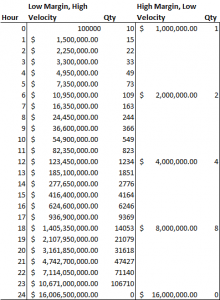Velocity of Money
<div>A commenter asked me why I keep insisting that the velocity of money is important, so I want to talk about that a little bit. Examples and numbers will be involved!
</div><div>
</div>
<div>The main concept behind the velocity of money is that an order that takes 6 hours to complete at a relatively low margin can be far better, in terms of net profit, than an order that takes 24 hours to complete at a high margin. This is because you can repeat the 6 hour order 4 times in 24 hours and end up with a higher net income than the high margin item.</div><div>
</div><div>Below is a table that illustrates how velocity of isk can work in a completely theoretical manner. The setup is: </div><div></div><ul><li>Widget A can be bought for $100,000, sells for $150,000, and each item sells in 1 hour.</li><li>Widget B can be bought for $1,000,000, sells for $2,000,000, and each item sells in 6 hours.</li><li>The example player starts with $1,000,000 isk.</li><li>Sales tax and broker’s fees are ignored.</li></ul><div>Here is what happens in one day (24 hours):</div><div>
</div><div style="clear: both; text-align: center;"> </div><div> </div>
</div><div> </div>
<div>Widget A is an insane money maker! At the end of one day of trading it made 16 B isk! Obviously this is not a real case. There is no item in the game that moves 100,000+ units an hour and has a price near $100,000. There are also very few items that will consistently flip every single hour of each day. But the theory is sound. Push the Widget numbers out to every 3 hours, and drop a cycle near the beginning to diversify the profits, and you will get a few staggered version of that curve, limited by the daily trading volumes. Widget A will still net far more than just betting on that 1 million isk high margin order!
</div><div>In summary: diversify across a lot of small orders that are all moving quickly in order to keep your volume clipping along. Add in big orders as your capital allows you to take longer-term investments. If all of your isk gets tied up in order that take forever to move, you may be missing out on more boring, but useful trades.